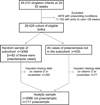Maternal vitamin D status and the risk of mild and severe preeclampsia
- PMID: 24457526
- PMCID: PMC4053531
- DOI: 10.1097/EDE.0000000000000039
Maternal vitamin D status and the risk of mild and severe preeclampsia
Abstract
Background: We sought to determine the association between maternal vitamin D status at ≤26 weeks' gestation and the risk of preeclampsia by clinical subtype.
Methods: We conducted a case-cohort study among women enrolled at 12 US sites from 1959 to 1966 in the Collaborative Perinatal Project. In serum collected at ≤26 weeks' gestation (median 20.9 weeks) from 717 women who later developed preeclampsia (560 mild and 157 severe cases) and from 2986 mothers without preeclampsia, we measured serum 25-hydroxyvitamin D, over 40 years later, using liquid chromatography-tandem mass spectrometry.
Results: Half of women in the subcohort had 25-hydroxyvitamin D (25(OH)D) >50 nmol/L. Maternal 25(OH)D 50 to 74.9 nmol/L was associated with a reduction in the absolute and relative risk of preeclampsia and mild preeclampsia compared with 25(OH)D <30 nmol/L in the crude analysis but not after adjustment for confounders, including race, prepregnancy body mass index, and parity. For severe preeclampsia, 25(OH)D ≥50 nmol/L was associated with a reduction in three cases per 1000 pregnancies (adjusted risk difference = -0.003 [95% confidence interval = -0.005 to 0.0002]) and a 40% reduction in risk (0.65 [0.43 to 0.98]) compared with 25(OH)D <50 nmol/L. Conclusions were unchanged (1) after restricting to women with 25(OH)D measured before 22 weeks' gestation or (2) with formal sensitivity analyses for unmeasured confounding.
Conclusions: Maternal vitamin D deficiency may be a risk factor for severe preeclampsia but not for its mild subtypes. Contemporary cohorts with large numbers of severe preeclampsia cases would be needed to confirm or refute these findings.
Similar articles
-
Vitamin D status in early pregnancy and risk of preeclampsia.Am J Obstet Gynecol. 2015 Apr;212(4):511.e1-7. doi: 10.1016/j.ajog.2014.11.009. Epub 2014 Nov 13. Am J Obstet Gynecol. 2015. PMID: 25446694 Free PMC article.
-
Low maternal 25-hydroxyvitamin D concentration increases the risk of severe and mild preeclampsia.Ann Epidemiol. 2016 Dec;26(12):853-857.e1. doi: 10.1016/j.annepidem.2016.09.015. Epub 2016 Oct 8. Ann Epidemiol. 2016. PMID: 27818017 Free PMC article.
-
A nested case-control study of midgestation vitamin D deficiency and risk of severe preeclampsia.J Clin Endocrinol Metab. 2010 Nov;95(11):5105-9. doi: 10.1210/jc.2010-0996. Epub 2010 Aug 18. J Clin Endocrinol Metab. 2010. PMID: 20719829 Free PMC article.
-
Comparing levels of vitamin D, calcium and phosphorus in normotensive pregnant women and pregnant women with preeclampsia.J Obstet Gynaecol. 2020 Nov;40(8):1069-1073. doi: 10.1080/01443615.2019.1678575. Epub 2019 Dec 8. J Obstet Gynaecol. 2020. PMID: 31814492 Review.
-
Vitamin D and pregnancy outcomes: Overall results of the FEPED study.J Gynecol Obstet Hum Reprod. 2020 Oct;49(8):101883. doi: 10.1016/j.jogoh.2020.101883. Epub 2020 Jul 27. J Gynecol Obstet Hum Reprod. 2020. PMID: 32730862 Review.
Cited by
-
Hypertension in CKD Pregnancy: a Question of Cause and Effect (Cause or Effect? This Is the Question).Curr Hypertens Rep. 2016 Apr;18(5):35. doi: 10.1007/s11906-016-0644-7. Curr Hypertens Rep. 2016. PMID: 27072828 Review.
-
Vitamin D and Inflammatory Cytokines in Healthy and Preeclamptic Pregnancies.Nutrients. 2015 Aug 4;7(8):6465-90. doi: 10.3390/nu7085293. Nutrients. 2015. PMID: 26247971 Free PMC article. Review.
-
Periconceptional folic acid fortification for the risk of gestational hypertension and pre-eclampsia: a meta-analysis of prospective studies.Matern Child Nutr. 2016 Oct;12(4):669-79. doi: 10.1111/mcn.12209. Epub 2015 Aug 11. Matern Child Nutr. 2016. PMID: 26260406 Free PMC article. Review.
-
Maternal vitamin D status, prolonged labor, cesarean delivery and instrumental delivery in an era with a low cesarean rate.J Perinatol. 2015 Jan;35(1):23-8. doi: 10.1038/jp.2014.139. Epub 2014 Aug 7. J Perinatol. 2015. PMID: 25102320 Free PMC article.
-
Programming of maternal and offspring disease: impact of growth restriction, fetal sex and transmission across generations.J Physiol. 2016 Sep 1;594(17):4727-40. doi: 10.1113/JP271745. Epub 2016 Apr 24. J Physiol. 2016. PMID: 26970222 Free PMC article. Review.
References
-
- Roberts JM. Pregnancy related hypertension. In: Creasy RK, Resnik R, editors. Maternal Fetal Medicine. Philadelphia: W.B. Saunders; 1998. pp. 883–872.
-
- Goldenberg RL, Rouse DJ. Prevention of premature birth. N Engl J Med. 1998;339(5):313–320. - PubMed
-
- Diagnosis and management of preeclampsia and eclampsia. ACOG Practice Bulletin No. 33. American College of Obstetricians and Gynecologists. Obstet Gynecol. 2002;99:159–167. - PubMed
-
- Holick MF. Vitamin D deficiency. N Engl J Med. 2007;357(3):266–281. - PubMed
Publication types
MeSH terms
Substances
Grants and funding
LinkOut - more resources
Full Text Sources
Other Literature Sources
Medical


